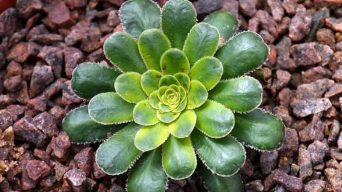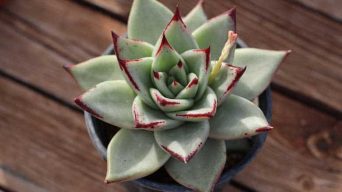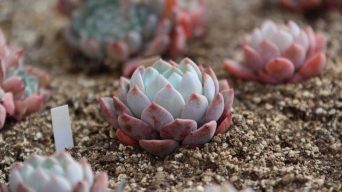If you’ve seen aerial roots on succulents, you may wonder what they are and why they grow.
Aerial roots, also called air roots, are an interesting and common occurrence on succulents.
While they may look unsightly or even harmful, they usually are not a cause for concern.
Aerial roots often play an essential role in the health and growth of a plant.
This article will discuss why aerial roots grow on succulents and what to do about them.
Why Do Succulents Grow Aerial Roots?
Aerial roots are a type of root that grows above the ground. They grow on the plant’s stem, frequently near the leaves. They are typically white or pink and very thin and delicate.
Aerial roots are a type of adventitious root. Adventitious roots are any roots that form in places other than where the plant’s main root system is.
Most plants have one central taproot that grows deep into the ground and smaller lateral roots extending out from this main taproot’s sides.
Air roots form when a plant’s main taproot can no longer support the plant’s growth. The plant then forms aerial roots to help support itself.
They are usually found on plants that grow in moist or humid environments, where the aerial roots can absorb more moisture from the air.
Succulents, however, are a type of plant that does not need much water and can even grow in dry environments.
So why do succulents grow aerial roots?
To Absorb Water and Nutrients From de Air
Succulents can grow aerial roots to absorb water and nutrients from the air.
When plants cannot get enough water from the ground, they will grow aerial roots to help them get the water and nutrients they need.
The aerial roots are a way to get these essential nutrients directly to the plant without relying on the soil.
This is especially important for succulents that grow in dry environments. They can still get the moisture and nutrients they need to survive by growing aerial roots.
A succulent plant isn’t getting enough water from the soil for several reasons. It may not be watered often enough, the soil may be too dry, or it may have a poor drainage system.
Succulents thrive in well-draining soil, so if the potting soil doesn’t drain well, the roots may not be able to get enough water.
If you can identify why your succulent isn’t getting enough water from the ground, you can take steps to correct it and help your plant thrive!
To Anchor the Plant
Aerial roots on succulents are generally found where a portion of the plant is likely to drop, so the aerial roots can help anchor the plant to the soil when it falls.
If a plant’s roots are injured, or the succulent is etiolated due to insufficient light, it will grow aerial roots anticipating the contact with the ground.
It’s common for stretched and leggy succulents to grow aerial roots along the stems, as they tend to lean and fall over.
Succulents will start to grow leggy when they’re not getting enough light. If your plant is stretching and growing aerial roots, it’s likely because it needs more light.
Also, if a plant grows in an area where it might fall, such as on a cliff or rocky hill, aerial roots can help keep it in place.
They will grow along the stem and cling to any surface they can find, helping to keep the plant from toppling over.
In these cases, the air roots are signs that the plant is trying to survive in a difficult environment.
If you see aerial roots on your succulents, it’s essential to assess the plant’s environment and ensure it has everything it needs to thrive.
To Cling to Surfaces
Trailing succulents, such as Sedum morganianum (Burro’s tail) and Senecio rowleyanus (String of Pearls), grow roots to help them cling to surfaces.
These aerial roots will attach themselves to any surface they can find, helping the plant cling to its surroundings.
This is important for trailing succulents, as they rely on their roots to help them stay in place.
If you see aerial roots on your trailing succulents, it’s a good sign! This means that the plant is healthy and can cling to its surroundings.
If you find that the aerial roots are not attaching themselves to anything, you may need to support the plant.
This can be something as simple as a wire trellis or a string tied to two posts.
If you provide support for your trailing succulents, they can grow aerial roots and cling to surfaces easily!
To Reproduce
In some cases, aerial roots can help a plant reproduce.
For example, when a stem from a succulent break off and falls to the ground, roots will grow from the stem.
These aerial roots will take root in the soil and help the plant grow a new stem.
This is a way for the succulents to propagate and create new plants.
Do All Types of Succulents Grow Aerial Roots?
No, not all succulents grow aerial roots. Aerial roots tend to grow in succulents with a stem.
Some common succulents that DO grow aerial roots are Echeveria, Crassula, Sedum, and Sempervivum (Hens and Chicks).
These types of succulents tend to stretch and grow aerial roots when they’re not getting enough light.
In addition, aerial roots are more common in fast-growing succulents, such as the Graptopetalum’ Fred Ives’ and the Graptopetalum Superbum.
Furthermore, trailing succulents, such as Peperomia prostrata (String of Turtles) and Curio radicans (String of Bananas), will also grow aerial roots to help them cling to surfaces.
On the other hand, some common succulents that DO NOT grow aerial roots are Aloe, Haworthia, and Sansevieria (Snake Plant).
These plants generally don’t need aerial roots to survive and only grow them in specific circumstances.
Aerial roots are more common in certain types of succulents than others. However, all succulents have the potential to grow aerial roots if they need to.
What To Do With Aerial Roots on Succulents
Aerial roots are a sign that the succulent is trying to survive in a difficult environment.
If you see aerial roots, it’s essential to assess the plant’s environment and ensure it has everything it needs to thrive.
If your plant is stretching and has aerial roots, it’s likely because it needs more light.
Move the plant to a brighter location and ensure it gets at least six hours of direct sunlight daily.
In addition, if your plant is growing aerial roots in an attempt to reproduce, leave it alone!
The aerial roots will take root in the soil and create a new plant.
However, if your succulent is growing aerial roots because it’s not getting enough water, you’ll need to water it more often.
Ensure the pot has drainage holes and the soil is dry to the touch before watering.
But while aerial roots aren’t harmful, they can be unsightly.
You can trim them off if you don’t like how they look. However, you should also avoid trimming aerial roots that are growing from the base of the plant, as these are important for the plant’s stability.
If you’re unsure whether or not to trim aerial roots, it’s always best to err on caution and leave them be.
When the underlying cause of aerial root growth is corrected, the aerial roots will eventually stop growing and fall off on their own.
Final Thoughts
Aerial roots on succulents are not harmful and can be pretty beneficial.
They are a natural phenomenon caused by the plant’s attempt to survive in its environment.
If your succulent has aerial roots, make sure to assess its environment and give it what it needs to thrive.
If you don’t like how they look, you can trim them off, but first, identify the underlying cause of their growth.
With the proper care, your succulent will be healthy in no time!







